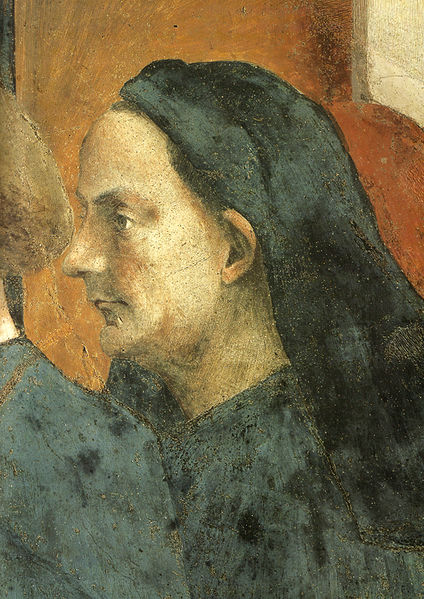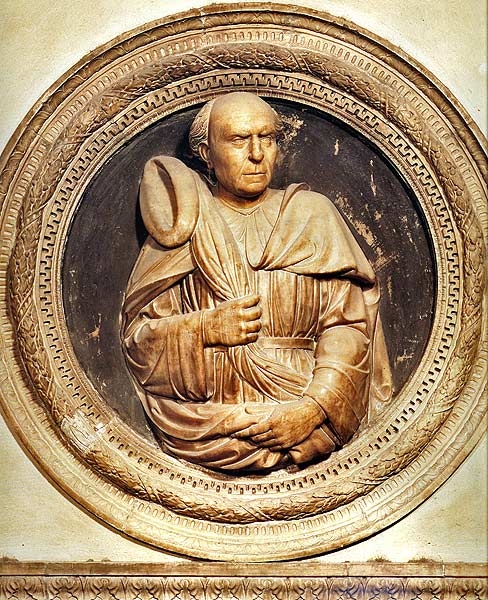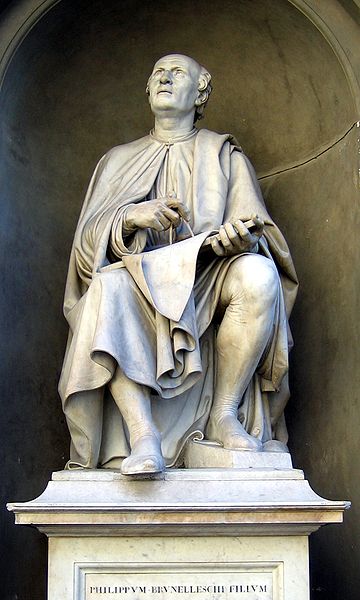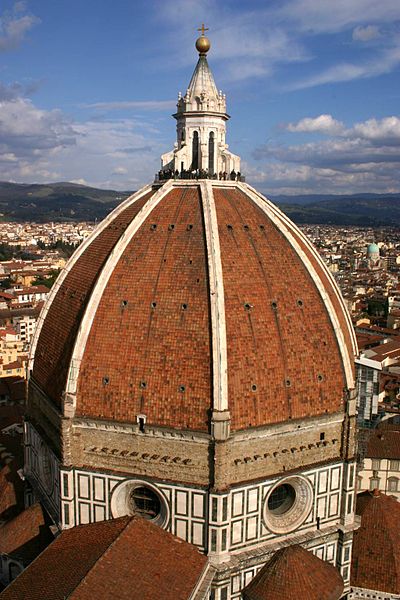<Back to Index>
- Architect Filippo Brunelleschi, 1377
PAGE SPONSOR



Filippo Brunelleschi (1377 – April 15, 1446) was one of the foremost architects and engineers of the Italian Renaissance. He is perhaps most famous for inventing linear perspective and designing the dome of the Florence Cathedral, but his accomplishments also included bronze artwork, architecture (churches and chapels, fortifications, a hospital, etc), mathematics, engineering (hydraulic machinery, clockwork mechanisms, theatrical machinery, etc) and even ship design. His principal surviving works are to be found in Florence, Italy.
Very little is known about the early life of Brunelleschi; the only sources are Antonio Manetti and Giorgio Vasari. According to these sources, Filippo's father was Brunellesco di Lippo, a lawyer, and his mother was Giuliana Spini. Filippo was the middle of their three children. The young Filippo was given a literary and mathematical education intended to enable him to follow in the footsteps of his father, a civil servant. Being artistically inclined, however, Filippo enrolled in the Arte della Seta, the silk merchants' Guild, which also included goldsmiths, metalworkers, and bronze workers. He became a master goldsmith in 1398. It was thus not a coincidence that his first important building commission, the Ospedale degli Innocenti, came from the guild to which he belonged.
In 1401, Brunelleschi entered a competition to design a new set of bronze doors for the baptistery in Florence. Along with another young goldsmith, Lorenzo Ghiberti, he produced a gilded bronze panel, depicting the Sacrifice of Isaac. His entry made reference to the Greco - Roman Boy with Thorn, whilst Ghiberti used a naked torso for his figure of Isaac. In 1403, Ghiberti was announced the victor, largely because of his superior technical skill: his panel showed a more sophisticated knowledge of bronze casting; it was completed in one single piece. Brunelleschi's piece, by contrast, consisted of numerous pieces bolted to the back plate. Ghiberti went on to complete a second set of bronze doors for the baptistery, whose beauty Michelangelo extolled a hundred years later, saying "surely these must be the "Gates of Paradise".
There
is little biographical information about Brunelleschi's life to explain
his transition from goldsmith to architect and, no less importantly,
from his training in the gothic or medieval manner to the new
classicism in architecture and urbanism that we now loosely call the Renaissance and of which Brunelleschi is considered the seminal figure. By 1400 there emerged an interest in humanitas which
contrasted with the formalism of the medieval period, but initially
this new interest in Roman antiquity was restricted to a few scholars,
writers and philosophers; it did not at first influence the visual
arts. Apparently it was in this period (1402 – 1404) that Brunelleschi
and his friend Donatello visited Rome to
study the ancient Roman ruins. Donatello, like Brunelleschi, had
received his training in a goldsmith's workshop, and had then worked in
Ghiberti's studio. Although in previous decades the writers and
philosophers had discussed the glories of ancient Rome, it seems that
until Brunelleschi and Donatello made their journey, no one had studied
the physical fabric of these ruins in any great detail. They gained
inspiration too from ancient Roman authors, especially Vitruvius whose De Architectura provided an intellectual framework for the standing structures still visible.
Brunelleschi's first architectural commission was the Ospedale degli Innocenti (1419 – ca.1445), or Foundling Hospital. Its long loggia would have been a rare sight in the tight and curving streets of Florence, not to mention its impressive arches, each about 8 m high. The building was dignified and sober; there were no displays of fine marble and decorative inlays. It was also the first building in Florence to make clear reference — in its columns and capitals — to classical antiquity.
Soon other commissions came, such as the Ridolfi Chapel in the church of San Jacopo sopr' Arno, now lost, and the Barbadori Chapel in Santa Trinita, also modified since its building. For both Brunelleschi devised elements already used in the Ospedale degli Innocenti, and which will also use in the Pazzi Chapel and the Sagrestia Vecchia; at the same time he used such smaller works as a sort of feasibility tests for his most famous work, the dome of the Cathedral of Florence.
Santa Maria del Fiore was the new cathedral of the city, and by 1418 the dome had yet to be defined. When the building was designed in the previous century, no one had any idea about how such a dome was to be built, given that it was to be even larger than the Pantheon's dome in Rome and that no dome of that size had been built since antiquity. Because buttresses were forbidden by the city fathers, and clearly was impossible to obtain rafters for scaffolding long and strong enough (and in sufficient quantity) for the task, it was unclear how a dome of that size could be built, or just avoid collapse. It must be considered also that the stresses of compression were not clearly understood at the time, and the mortars used in the periods would only set after several days, keeping the strain on the scaffolding for a very long time. In 1419, the Arte della Lana, the wool merchants' guild, held a competition to solve the problem. The two main competitors were Ghiberti and Brunelleschi, with Brunelleschi winning and receiving the commission.
The competition consisted of the great architects attempting to stand an egg upright on a piece of marble. None could do it but Brunelleschi, who, according to Vasari:
...giving one end a blow on the flat piece of marble, made it stand upright...The architects protested that they could have done the same; but Filippo answered, laughing, that they could have made the dome, if they had seen his design.
The dome, the lantern (built 1446 – ca.1461) and the exedrae (built 1439 - 1445) would occupy most of Brunelleschi’s life. Brunelleschi's success can be attributed to no small degree to his technical and mathematical genius. Brunelleschi used more than 4 million bricks in the construction of the dome. He invented a new hoisting machine for raising the masonry needed for the dome, a task no doubt inspired by republication of Vitruvius' De Architectura, which describes Roman machines used in the first century AD to build large structures such as the Pantheon and the Baths of Diocletian, structures still standing which he would have seen for himself. He also issued one of the first patents for the hoist in an attempt to prevent theft of his ideas. Brunelleschi was granted the first modern patent for his invention of a river transport vessel.
Of the two churches that Brunelleschi designed, the Basilica of San Lorenzo, (1419 - 1480s) and Santo Spirito (1441 – 1481), both of which are considered landmarks in Renaissance architecture, the latter is seen as conforming most closely to his ideas.
Brunelleschi's interests extended to mathematics and engineering and the study of ancient monuments. He invented hydraulic machinery and elaborate clockwork, none of which survives.
Brunelleschi also designed fortifications used by Florence in its military struggles against Pisa and Siena. In 1424, he did work in Lastra a Signa, a village protecting the route to Pisa, and in 1431 he did work to the south, on the walls of the village of Staggia. The latter walls are still preserved, but whether these are specifically by Brunelleschi is uncertain.
He also had a brief appearance in the world of shipmaking, when, in 1427, he built a monstrous ship called Il Badalone to transport marble to Florence from Pisa up the Arno River. The ship sank on its first voyage, along with a sizable chunk of Brunelleschi's personal fortune.
Besides accomplishments in architecture, Brunelleschi is also credited with inventing one - point linear perspective which
revolutionized painting and allowed for naturalistic styles to develop
as the Renaissance digressed from the stylized figures of medieval art.
In addition, he was somewhat involved in urban planning: he
strategically positioned several of his buildings in relation to the
nearby squares and streets for "maximum visibility". For example,
demolitions in front of San Lorenzo were approved in 1433 in order to
create a piazza facing the church. At Santo Spirito, he suggested that
the façade be turned either towards the Arno so travelers would
see it, or to the north, to face a large, prospective piazza.
The first known paintings in geometric optical linear perspective were made by Brunelleschi about 1425. His biographer, Antonio Manetti, described this famous experiment in which Brunelleschi painted two panels; the first of the Florentine Baptistery as viewed frontally from the western portal of the unfinished cathedral, and second the Palazzo Vecchio as seen obliquely from its northwest corner.
The first Baptistery panel was constructed with a hole drilled through the centric vanishing point. Curiously, Brunelleschi intended that it only be observed by the viewer holding the unpainted back of the picture against his/her eye with one hand, and a mirror in the other hand facing and reflecting the painted side. In other words, Brunelleschi wanted his new perspective "realism" to be tested not by comparing the painted image to the actual Baptistery but to its reflection in a mirror according to the Euclidean laws of geometric optics. This feat showed artists for the first time how they might paint their images, no longer merely as flat two - dimensional shapes, but looking more like three - dimensional volumes just as mirrors reflect them. Unfortunately, both panels have since been lost.
Soon after, linear perspective as a novel artistic tool spread not only in Italy but throughout western Europe, and quickly became standard studio practice up to and including present time.
Another of Brunelleschi’s activities was the designing of the machinery in churches for theatrical, religious performances that reenacted Biblical miracle stories. Contrivances were created by which characters and angels were made to fly through the air in the midst of spectacular explosions of lights and fireworks. These events took place during state and ecclesiastical visits. Though it is not known for certain how many of these Brunelleschi designed, but it seems that at least one, for the church of S. Felice, is confirmed in the records.
Brunelleschi's body lies in the crypt of the Cathedral of Florence. As explained by Antonio Manetti, who knew Brunelleschi and who wrote his biography, Brunelleschi "was granted such honors as to be buried in the Basilica di Santa Maria del Fiore, and with a marble bust, which they say was carved from life, and placed there in perpetual memory with such a splendid epitaph." Inside
the cathedral entrance is this epitaph: "Both the magnificent dome of
this famous church and many other devices invented by Filippo the
architect, bear witness to his superb skill. Therefore, in tribute to
his exceptional talents, a grateful country that will always remember
buries him here in the soil below."
